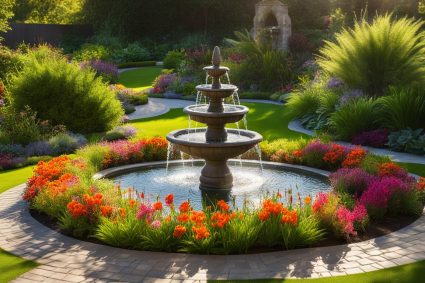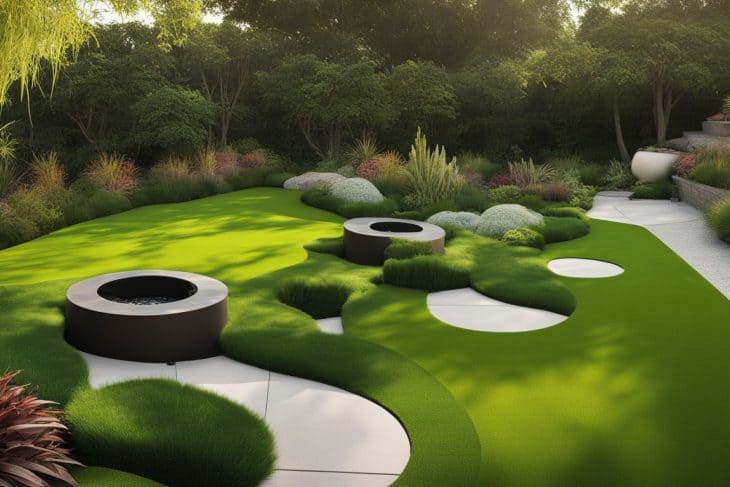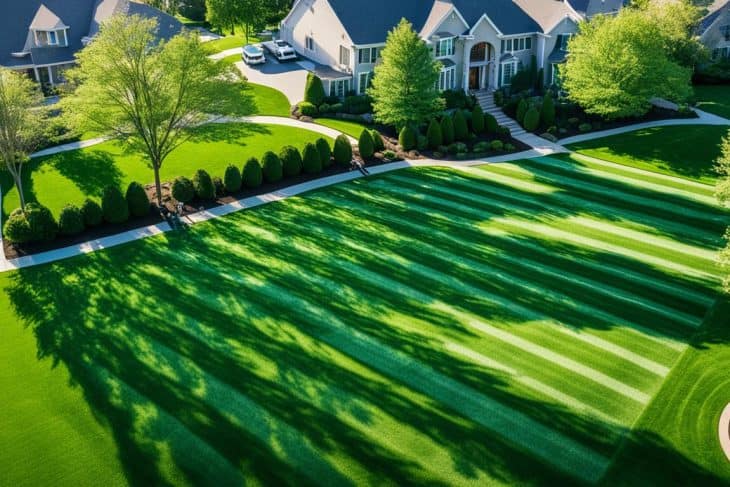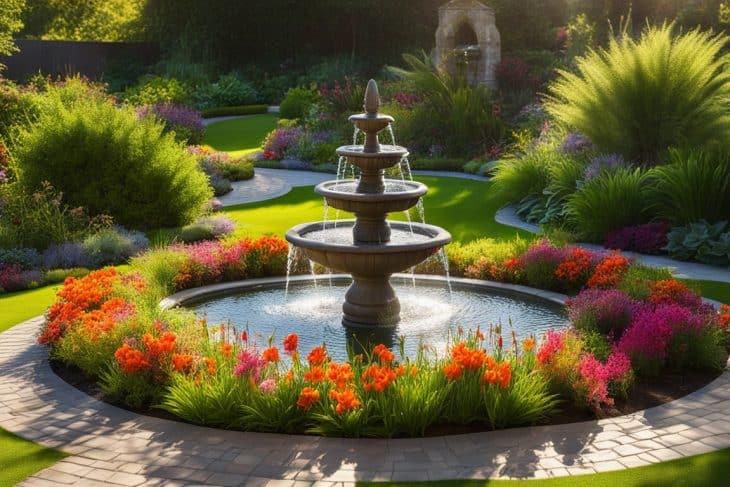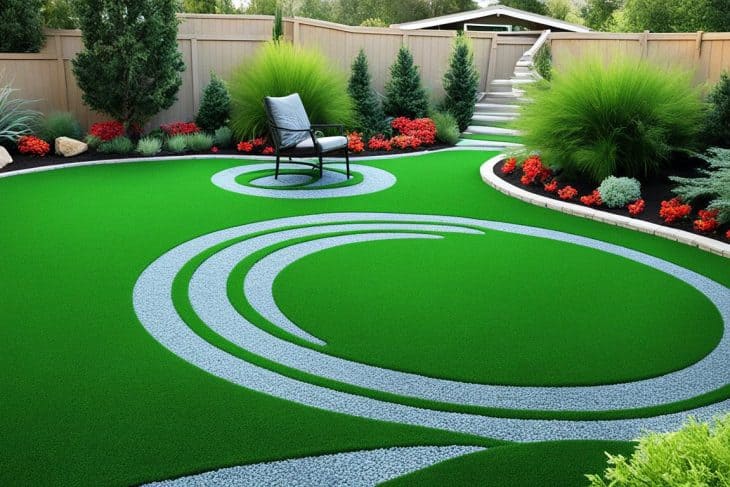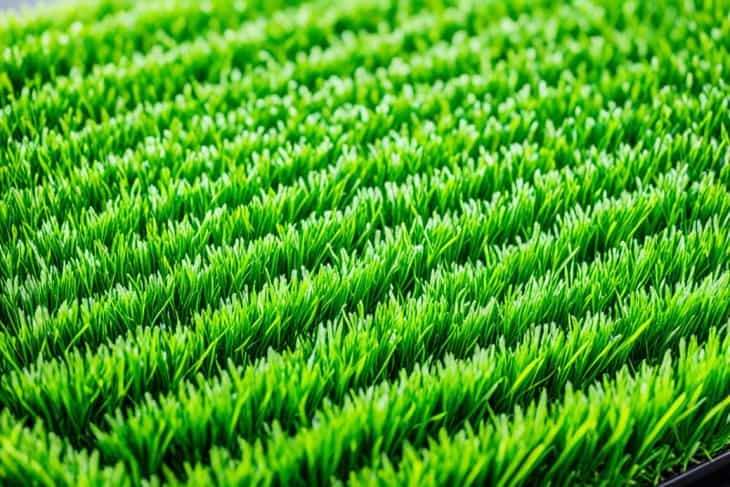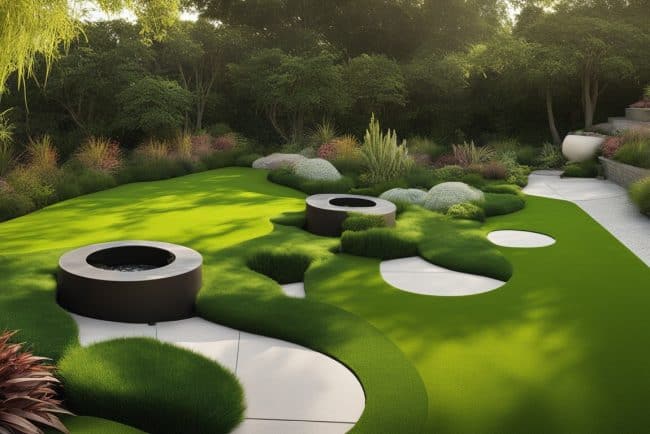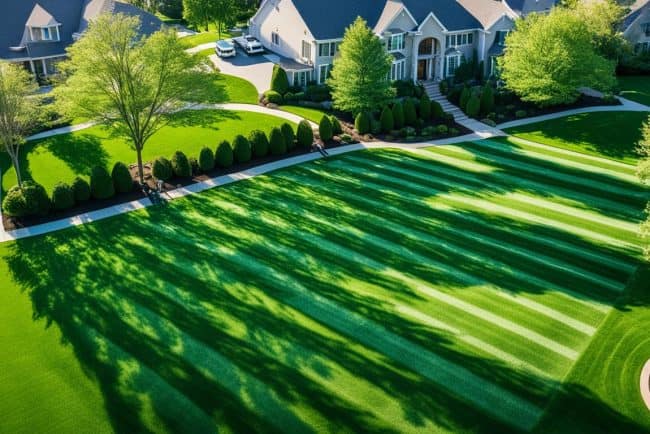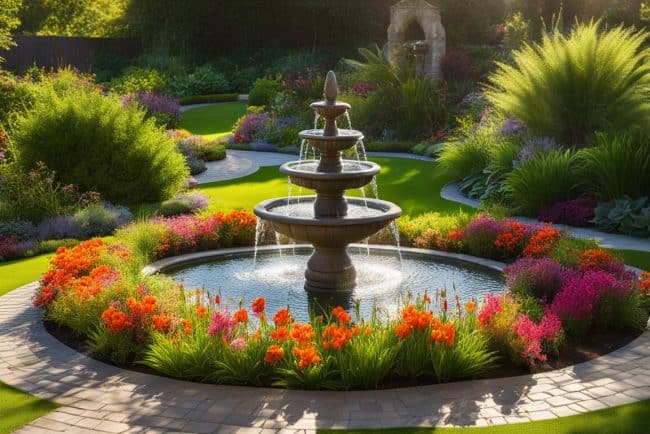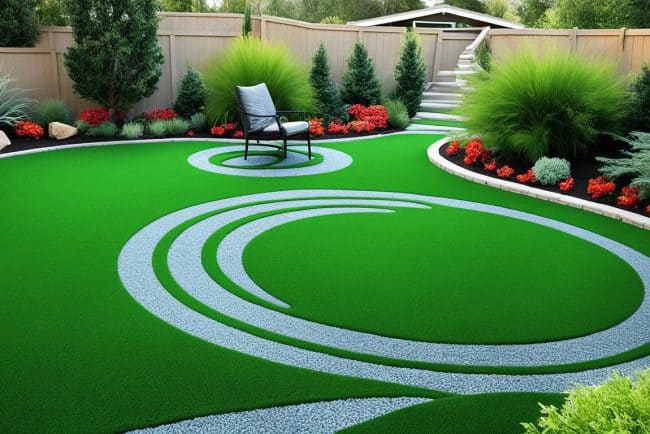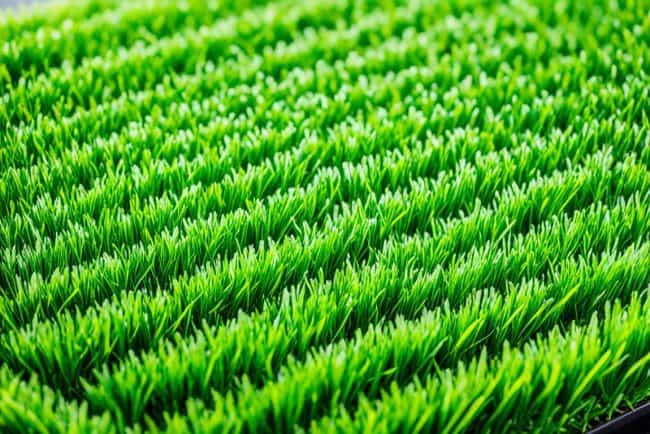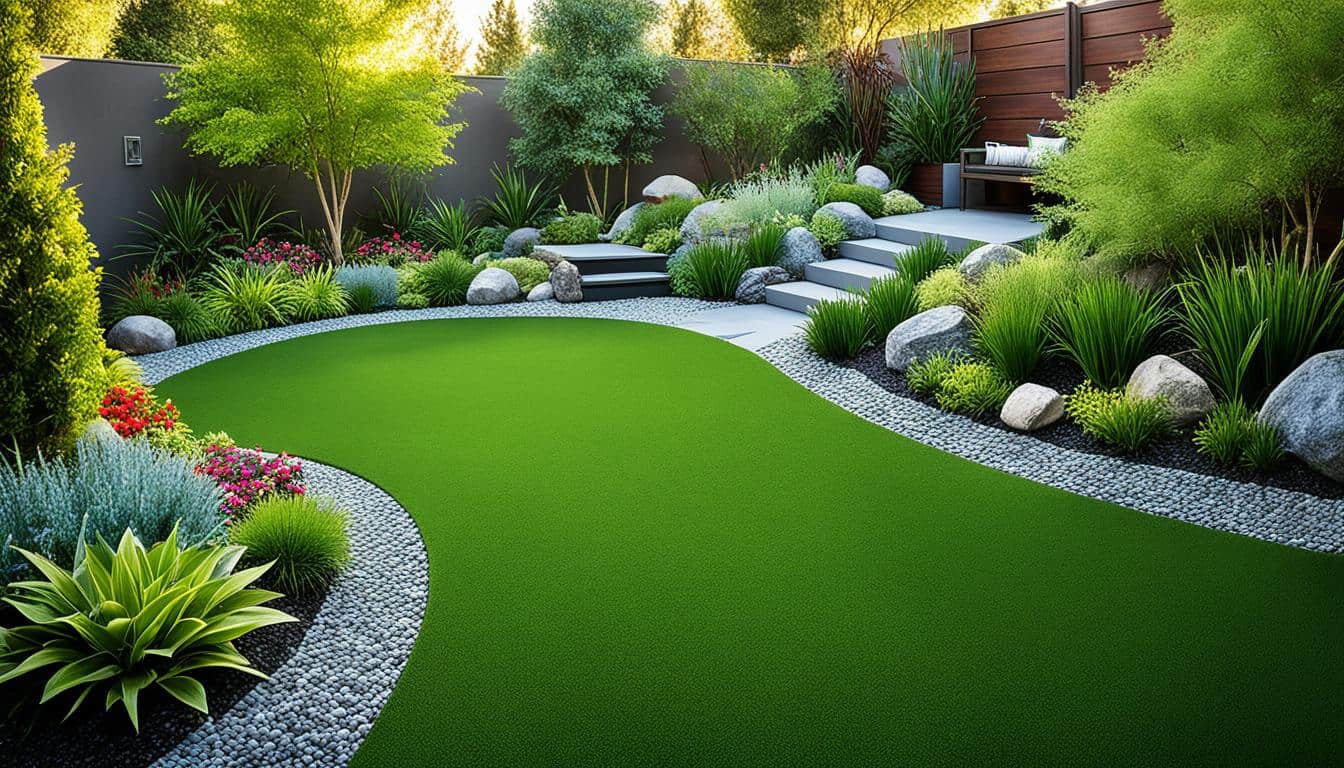
Did you know artificial grass can save up to 55 gallons of water per square foot every year? This is crucial in times where drought is more common. Synthetic turf is becoming popular for those wanting to save water, cut lawn maintenance costs, and be more eco-friendly.
Exploring eco-friendly turf, I’m amazed at how companies like SYNLawn and LawnPop are leading in sustainable gardening. They make durable products that offer a green lawn without harming the environment. This is changing landscaping towards a better, sustainable future.
Choosing artificial grass helps us avoid harmful chemicals and save water. It lets us create beautiful and eco-friendly landscapes. We can work together on sustainable gardens for a positive, lasting impact.
Key Takeaways
- Artificial grass saves significant water compared to natural lawns.
- Using synthetic turf reduces chemical lawn care practices to zero.
- Switching to artificial grass lowers greenhouse gas emissions from lawn maintenance tools.
- Synthetic turf requires minimal upkeep and is durable against foot traffic.
- Thousands of households transitioning to synthetic lawns lead to reduced environmental footprints.
- Investing in artificial grass can lead to long-term financial savings.
Understanding Artificial Grass as a Sustainable Solution
Artificial grass is a smart, green choice for your yard. It looks like real grass but has less impact on our planet. Eco-friendly materials, like soy and sugarcane, are used to make it. Brands such as SYNLawn are at the forefront with these green practices.
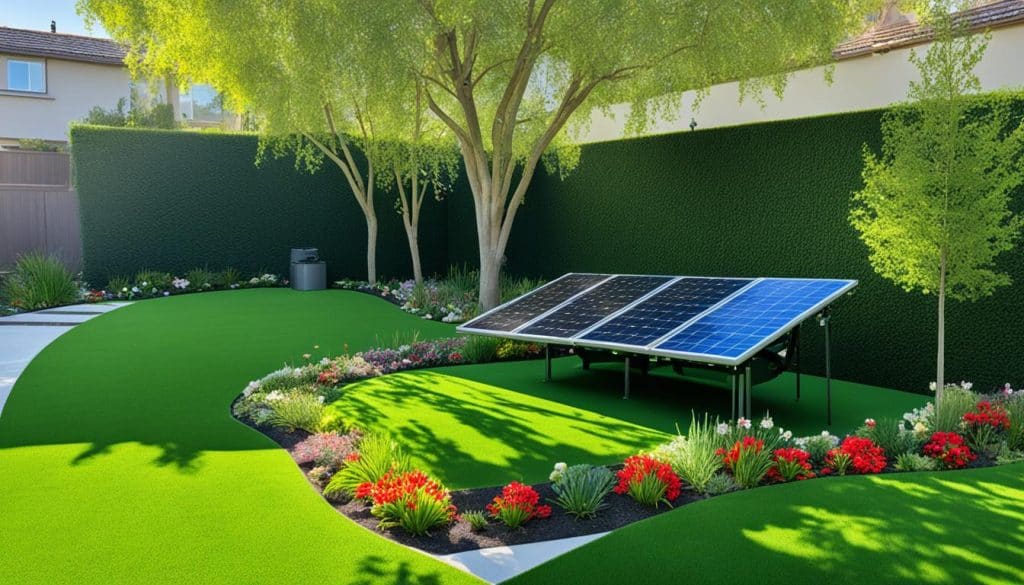
Switching to artificial grass cuts down water use dramatically. You won’t need as much water, which saves on bills. It also means avoiding harsh chemicals, making it safer for families and pets.
Artificial grass is low on upkeep, which is great for busy homeowners. You save time and money by not watering, cutting, or feeding your lawn. Plus, it stays green and pretty without fading, thanks to UV-resistant fibers.
Choosing artificial grass means you don’t have to worry about soil erosion. It also cuts down on allergens compared to regular grass. It’s a great way to make your outdoor area beautiful while being kind to the earth.
Water Conservation: The Key Benefit of Synthetic Turf
One big advantage of synthetic turf is it saves a lot of water. Normal grass needs about 55 to 60 gallons of water per square foot every year. Artificial grass cuts this to just 10 to 15 gallons. This big difference shows how artificial turf helps save water in landscaping.
In the U.S., outdoor water use at homes is nearly 9 billion gallons daily, mostly for watering plants. By choosing artificial turf, water use can drop by up to 70%. For a usual home, this is over 55 gallons of water saved per square foot of synthetic grass every year. This helps save water both for individuals and on a bigger scale.
In places with little water, groups like the Southern Nevada Water Authority highlight the value of water savings from artificial turf. Cities offer rebates to encourage people to use drought-friendly landscaping. The Metropolitan Water District of Southern California even gives money to help make this green choice easier for homeowners.
Artificial turf means steady water savings, making it easier for homeowners to plan their water use. This helps in managing water resources for the long term. It puts less pressure on city water systems, especially when lots of people water their gardens. Plus, artificial grass can last up to 20 years and doesn’t need watering.
Also, artificial grass is good for the planet. It works well with systems that collect rainwater. This means places that often have droughts can still have green yards without needing lots of water. It shows that lawns can be lovely and water-wise at the same time.
Mowing Down Expenses and Emissions
Keeping a regular lawn costs a lot of money over time. Americans spend billions every year on lawn care. This includes products, equipment, and services for over 40 million acres of grass.
The environmental effects of lawn care are big. Gasoline-powered lawn tools use about 800 million gallons of gas yearly. This hits your wallet hard and increases emissions.
Gas lawn mowers release a lot of pollution. Their two-stroke engines are much dirtier than car engines. Lawn tools add up to five percent of the U.S.’s air pollution. In 2011, they released 26.7 million tons of pollutants. It’s clear we need to switch to greener options like synthetic grass.
Lawn care is a major source of emissions. Switching to synthetic grass can help a lot. Electric mowers from companies like Stihl don’t emit any pollution. They’re also quieter and more efficient. Xeriscaping reduces the need for mowing and water, helping the environment.
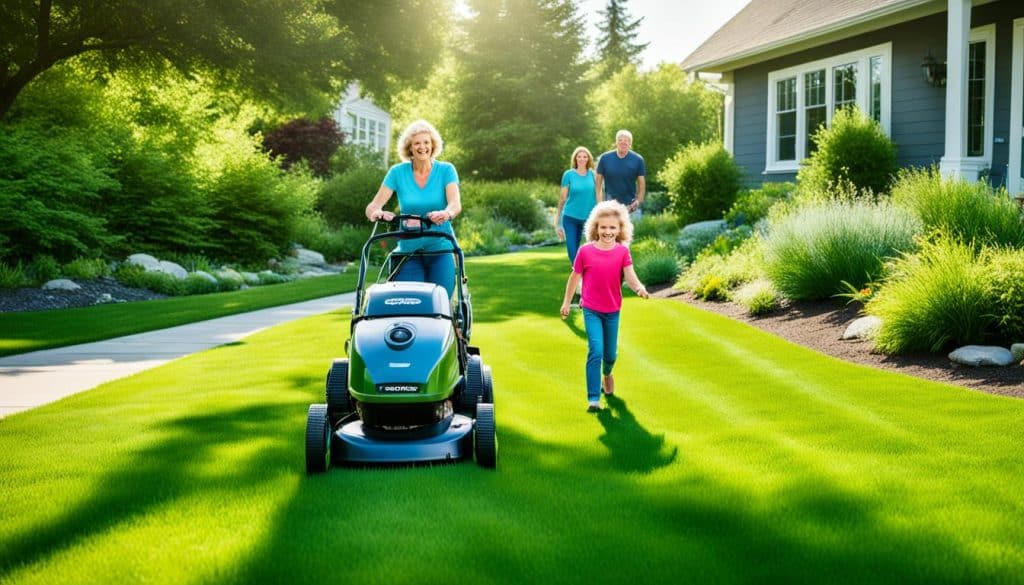
| Traditional Lawn Care | Synthetic Turf |
|---|---|
| High mowing costs | No mowing costs |
| Emissions from gas-powered mowers | Zero emissions |
| Annual fuel usage: 800 million gallons | No fuel required |
| Time spent mowing: 70 hours/year | Maintenance-free |
There’s strong evidence for using maintenance-free lawns. This can make a big difference for the planet and our pockets. Synthetic turf cuts mowing costs and emissions. It’s a smart choice for home landscapes.
Sustainable Yard Solutions for a Chemical-Free environment
You can create a lively outdoor area without harmful chemicals by using synthetic grass. More than 70 million pounds of pesticides are used every year in the U.S. for lawn care. This hurts local ecosystems and pollutes our water. Using artificial turf means you don’t need fertilizers, herbicides, or insecticides. It helps keep the environment chemical-free, healthy, and full of different living things.
It’s shocking to learn how much we maintain lawns and how much water they need. Lawns only cover 2% of the U.S. but use more water than any crop. The use of pesticides has decreased the number of helpful bugs like bees and ladybugs. Bees are very important because they help nearly 90% of flowering plants grow. Their loss has a big negative effect on nature.
Synthetic grass helps us care for good insects without using bad chemicals. Using Integrated Pest Management (IPM) lets natural predators live and reduces pesticide use. We can also control weeds in a natural way. We need to make landscaping choices that look good and are good for nature’s health.
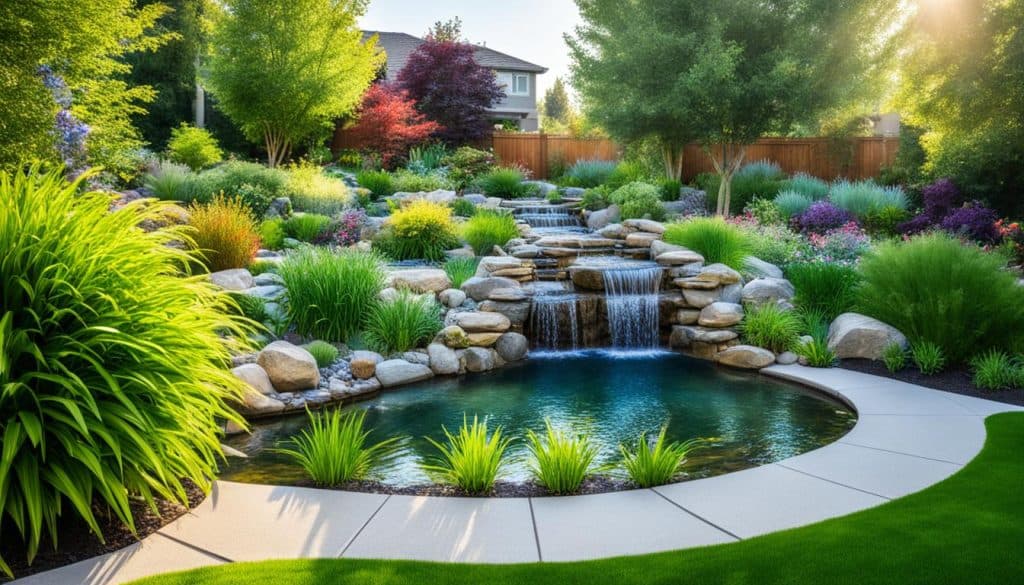
| Impact of Traditional Lawn Care | Benefits of Synthetic Turf |
|---|---|
| Uses over 70 million pounds of pesticides annually | Eliminates the need for pesticides |
| Contributes to declining bee populations | Encourages a thriving environment for pollinators |
| Requires significant water and gas for maintenance | Reduces overall water consumption |
| Displaces native ecosystems | Promotes biodiversity and habitat conservation |
In conclusion, choosing synthetic grass is a step toward nature-friendly landscaping. It helps us lessen harmful practices. By doing this, we make sure we have a healthier place for us and the future.
The Long-Term Financial Benefits of Synthetic Turf
Artificial grass offers big financial benefits that might not be obvious at first. Yes, it costs more at the start than real grass. But, you save a lot later on things like upkeep. I saw for myself how fake grass doesn’t need watering, cutting, feeding, or bug control. This cuts down yearly costs a lot, making it great for those watching their budget.
Synthetic turf stands up to lots of use and bad weather without getting ruined. It stays good in places that get a ton of feet on it or have tough weather. For example, top-notch products can last between 15 and 25 years. This means less fixing or replacing, saving money over time.
The money you save on water, lawn care, and buying less stuff helps balance out the initial higher price. In places like Texas, saving water is a big deal because there’s not a lot of it. Artificial grass uses very little water, lowering water bills and helping the planet. So, putting in synthetic grass is good for both your wallet and the earth.
Aesthetics: Achieving a Lush Green Lawn Without Compromise
The beauty of a lush green lawn often defines the aesthetic appeal of any home. Many may still harbor concerns about the visual quality of artificial grass. Advances in technology have resulted in artificial turf that mimics the look and feel of natural grass closely. Brands, such as Shawgrass, exemplify these innovations, offering various styles that cater to diverse homeowner preferences.
A well-maintained yard can increase property value by 15 to 20 percent. The vibrant colors and consistent texture of artificial grass offer an evergreen solution. They’re free from the seasonal browning that natural grass faces. The perception that artificial grass lacks beauty is outdated. Nowadays, it can boost the landscape’s charm. It ensures consistent care, letting me enjoy a stunning green space all year.
Maintaining a lush green lawn significantly cools the surrounding environment. Grass’s natural cooling effect makes outdoor experiences more pleasant than those on bare soil or asphalt. Additionally, healthy lawns act as natural filters for rainwater. They enhance air and water quality. This effectively reduces pollution and promotes cleaner local ecosystems.
By implementing practices like proper mowing techniques, aerating the lawn, and using organic soil amendments from providers like Fairway Lawns, I maintain my yard’s look and turf health. These methods greatly contribute to a lush lawn that stands the test of time.
| Practice | Benefit |
|---|---|
| Proper Mowing | Enhances lawn health and appearance |
| Aeration | Improves air and water circulation |
| Regular Maintenance | Prevents weeds and debris, ensuring vibrancy |
| Organic Soil Amendments | Enriches soil, promoting healthy growth |
| Water Management | Encourages deep root growth and conserves water |
For those of us looking to balance beauty with environmental care, artificial grass is a top choice. It offers a sustainable way to beautify and eco-proof our landscapes. Let this vibrant alternative enhance our outdoor experiences. It allows us to appreciate nature without compromise.
Embracing Sustainable Practices: How Artificial Grass Supports Biodiversity
In my journey to be more sustainable, I found out how artificial grass helps the environment. It cuts the need for harmful chemicals, like pesticides and fertilizers. This makes our gardens safe for different plants and animals.
Artificial grass also protects the soil from getting damaged. It stops soil erosion and keeps the soil healthy. By choosing synthetic turf, I help save a lot of water—up to 70 gallons per square foot every year. Plus, it reduces the carbon footprint from using gas-powered lawn tools.
Choosing artificial grass means I’m looking out for our planet. It’s not just about my backyard; it’s about supporting life all around us. By picking this sustainable option, I am doing my part for the earth. This choice helps build a better future for us all.
